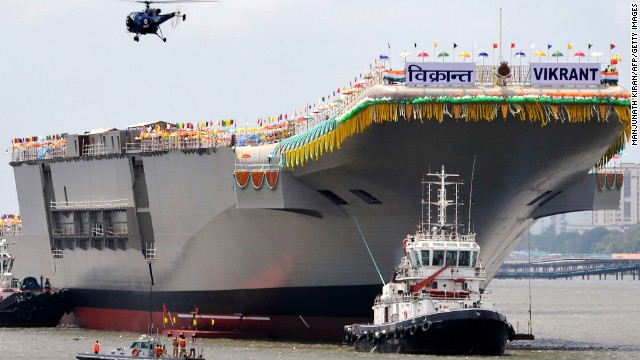印度自製的潛水艇, 航空母艦, 高分貝曝光. 表面上看起來: 美國養的那群狗裡面, 印度最稱職, 給大陸最大的壓力. 日本, 越南, 南韓, 都給比下去了!
想到臺灣這陣子混亂, 非要把軍隊給廢了不可的歪風. 甚至連在臉書上貼戎裝照, 都被戴帽子指責?

Vivek Prakash/Reuters
The naval yard in Mumbai where an explosion and fire on the diesel-powered submarine INS Sindhurakshak partly sank the vessel on Wednesday, trapping 18 sailors.
NEW DELHI — Indian naval divers on Wednesday afternoon opened the main hatchway of a stricken, Russian-made Indian submarine that caught fire, blew up and sank at dock earlier in the day in one of the worst naval accidents in Indian history.
Divyakant Solanki/European Pressphoto Agency
A gate at the naval yard in Mumbai where the Russian-made INS Sindhurakshak caught fire. Three sailors scrambled to safety.
But visibility for the divers within the sunken boat was almost zero, and the effort to rescue or recover the 18 missing crew members was expected to take time. Three sailors who were on the outside of the ship when it exploded managed to scramble to safety.
Adm. D. K. Joshi, India’s naval chief, said at a news conference that the chances were slim that any of the missing sailors remained alive.
“There is a possibility, however remote it might be, of an air pocket,” he said. “We hope for the best but have to be ready for the worst.”
The submarine was docked at the Lion Gate naval shipyard, close to South Mumbai’s busy financial district and within two miles of the Gateway of India. The water where the accident occurred is so shallow that part of the stricken vessel protruded above the surface.
Admiral Joshi said there had been no communication with the missing crew since a small explosion around midnight near the bow of the submarine ignited two huge blasts from onboard munitions, possibly torpedoes or cruise missiles. The heat from the explosions and the resulting two-hour fire was so intense that it fused the submarine’s hatchways, making rescue efforts even more challenging.
“We cannot rule out the possibility of sabotage, although the indicators at this time would not support that conclusion,” Admiral Joshi said. “It is essentially an onboard explosion.”
The cause of the explosion on the 16-year-old INS Sindhurakshak, could not be immediately determined. After a February 2010 explosion in the battery compartment left one dead and two injured, the vessel was sent to the Zvezdochka shipyard in Russia for a two-and-a-half-year, $80 million retrofit. It was handed back to the Indian Navy in January, and went on a three-month, 10,000-mile shakedown cruise that ended successfully in April in Mumbai.
The crew had recharged the sub’s batteries three days before the blast, so a battery leak was not a likely cause this time, Admiral Joshi said.
After divers explore the submarine for survivors, they will try to seal two or three internal compartments, expel the water and refloat the boat, Admiral Joshi said. Only then will investigators be able to begin to look into the causes of the accident.
Defense Minister A. K. Antony went to Mumbai, where the entrance to the shipyard was heavily guarded on Wednesday by police and naval personnel. A scrum of journalists and onlookers stood outside the gates for much of the day.
“I express my heartfelt condolences to the families of those sailors and officers who were inside this submarine,” the minister said at the news conference.
An Indian news channel, NDTV, broadcast a viewer’s video of what appeared to be a series of blasts lighting up the Mumbai sky. The explosions took place a day before India’s Independence Day celebrations, when security is normally tightened at government offices and military facilities.
The Sindhurakshak is one of the 10 Kilo-class submarines that form the backbone of India’s conventional submarine force. India is building a new class of conventional submarines, called the Scorpene, with French and Spanish help. But that effort, like many Indian defense projects, has been marred by delays and squabbling among its international partners, and the first submarines are not expected to be delivered until 2015 at the earliest.
India has long relied on Russian-made military equipment, including MIG-21 fighters, whose safety and reliability have been increasingly questioned. India is the largest arms buyer in the world because its own defense manufacturing industry has been unable to deliver high-quality, low-cost weapons to satisfy the country’s wide range of defense needs.
“This accident again raises questions about Russian standards of manufacture and repair,” Adm. Arun Prakash, who retired from the Indian Navy in 2006, said in an interview. “Russian equipment is not always the best, and it is prone to failures.”


 本城市首頁
本城市首頁













































